PinotFile: 11.33 November 2, 2018
|
Jeff Wilkes: Looking Back and ForwardJefferson James Wilkes contacted me back in the early 2000s and we arranged to have lunch and taste his J. Wilkes Pinot Noir wines. His wines from Bien Nacido Vineyard were a revelation, offering elegance and refinement instead of extraction and power so prevalent in California Pinot Noir wines of the time. We became friends and I continued to sample his wines until his untimely passing. Besides an enthusiasm for Pinot Noir, James was a proponent of Pinot Blanc, an under-appreciated mutation of Pinot Noir.
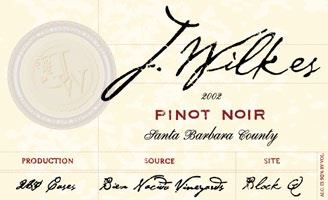 Currently, the J. Wilkes brand legacy has been revived by winemaker Wes Hagen, formerly of Close Pepe Estate Wines, who moved on in 2015 when the Clos Pepe Vineyard was leased to WALT Winery and became the winemaker and enthusiastic brand ambassador for J. Wilkes Wines based in Santa Maria. The Miller family owns Bien Nacido Vineyards, encompassing Bien Nacido and Solomon Hills vineyards, as well as J. Wilkes Wines. Estate wines from Bien Nacido and Solomon Hills vineyards are produced as distinctive vineyard-designated offerings, and grapes from both vineyards are sold to many exalted California wine producers. J. Wilkes Wines is a separate brand, specializing in AVA-designated wines. I asked Wes to look back and share his knowledge of the history of J. Wilkes Wines and his recollections of Jeff, and look forward in discussing his goals in continuing the J. Wilkes legacy. Wes is not only an accomplished winemaker and an industry leader in Santa Barbara wine, but he is also an accomplished wine writer, researcher and lecturer. He has talked on the history of wine in general and Santa Barbara wine in particular at many prestigious institutions and his writing has appeared in many prominent wine publications. He also had an instrumental role in the approval of the last three AVAs in Santa Barbara County: Sta. Rita Hills, Happy Canyon and Ballard Canyon. In his own words, this is what Wes had to say. I first had a proper wine conversation with Jeff Wilkes in 2005 when I was making wine for Clos Pepe Estate Wines at Central Coast Wine Services (CCWS) in Santa Maria, the same facility where he made his J. Wilkes Wines. I had met Jeff a few times at wine industry events, and we had chatted politely, but that day in 2005 was a bottling day, so we struck up a conversation about one of Jeff’s great passions: Pinot Blanc. We talked to the tank where his 2005 Pinot Blanc was waiting to be bottled. We retrieved a few glasses from the lab and walked over to the stainless tank and Jeff pulled us a few samples. The wine smelled of fresh nectarines and peach flesh, supported by a surprisingly nervy acidity and Old World saline minerality. Here, finally, was a wine that reflected pure Santa Maria typicality, but was also a homage to the land where Pinot Blanc expresses itself at the highest level (with apologies to the Alto Adige). We have all tasted seminal wines that changed us, and Jeff’s 2005 Pinot Blanc was one of those wines for me. Our ‘meeting of the minds and palates’ was a strong foreshadowing of a future I wasn’t expecting. That I would be the winemaker at J. Wilkes a decade later never entered my mind. Now in my fourth vintage as the winemaker at J. Wilkes (2015-2018), I never want to lose sight of Jeff’s history in establishing the brand and his goals as a winemaker. Here is how the brand began in Jeff Wilkes’ words. “The roots of our new beginning actually took hold in 1984. I had just accepted a position with the Miller family’s Bien Nacido Vineyard in the Santa Maria Valley of California to help market the grapes produced there during one of the largest grape gluts in California history. I was reviewing the wines produced from Bien Nacido Vineyard and tasted the only still red wine produced from our Pinot Noir vines. Most of the Pinot Noir we grew was made into sparkling wine at that time. However, the 1982 Austin Cellars Bien Nacido Vineyard Pinot Noir had just been released and not only did I feel that Pinot Noir was the future for our flagship vineyard, but I knew this was my future.” Jeff met Bobby Miller (part of the Miller Family) at the Santa Barbara Yacht Club (SBYC). Jeff had a great love for the sea and sailing, and Bobby had a boat named ‘Free Run.’ My conversations with Jeff’s friends at the SBYC confirmed that he was a quiet crewman, usually smoking a cigarette and taking in the view, until he was needed to adjust, pull, hoist, clamber or fix something on the boat, at which time he became an incredibly valuable ‘salt.’ Kent Pierce, a friend of Jeff’s, told me, “There wasn’t anything on the ‘Free Run’ that Jeff couldn’t tweak, improve or fix. He was a natural sailor, a problem-fixer, a good friend, and an amazing conversationalist.” The Miller Family of Santa Barbara County (Steve, Ladeen, Marshall, Nicholas and their families) has been farming fruit on the Central Coast since 1981. In 1969, the year I was born, they had purchased much of the Rancho Tepusquet and an adjacent parcel in order to plant grapes. Their first vineyard was planted in 1973 and was called ‘Bien Nacido’ after the planting crew’s insistence that it was a ‘well-born’ vineyard because it used some of the first metal trellis materials installed on the Central Coast. About ten years after the vineyard was planted, the Millers needed someone to promote and sell the fruit from Bien Nacido Vineyard, as a glut of wine grapes was impacting price per ton, making a difficult business even harder. By this time, Jeff was a fixture on Bobby Miller’s ‘Free Run’ boat in the Santa Barbara harbor, and Bobby recognized Jeff’s commitment. Bobby hoped that this dedication would transfer to grape sales and promotion. Jeff related more of his personal story. “During my 18 years at the Millers’ vineyards, my goal was for Bien Nacido Vineyard to be recognized as one of the premier Pinot Noir vineyards in the country. Along with the marketing and sales of the grapes, I focused on improving farming techniques and upgrading the trellises. I spent a lot of time on the road visiting other vineyards throughout California, looking at what other vineyards were doing, tasted the resulting wines and bringing this research back so that we could take advantage of the best techniques around. During this time, I tasted the best Pinots from all over California and France. Because I was spending untold hours visiting wineries and talking with winemakers, I developed a real sense of how I wanted to produce wine personally.” There is a great story that the last contract for grapes that Jeff ever sold was to himself in order to start making wines under his own J. Wilkes label. The story goes that he signed his own contract and then gave his notice to the Miller family. He was then offered the opportunity to make his J. Wilkes wines at Central Coast Wine Services, owned by the Miller family. The Millers and Jeff would be linked for Jeff's entire wine career. Jeff’s story goes on. “In 2001, I decided to venture out with the goal of making world-class wines. Initially, I limited my production to Pinot Noir, attempting to source grapes from the finest vineyards in California’s Central Coast. I also wanted to produce a white wine, so I added a Pinot Blanc in 2004. My promise is that J. Wilkes will always produce small lots of handcrafted wine using the finest grapes to make wines of distinction. by sourcing grapes from carefully selected sites and then using a combination of modern and traditional winemaking techniques, J. Wilkes wines will show the best characteristics of traditional Pinot Noir and Pinot Blanc.” We lost Jeff Wilkes in December 2010, far too early, and a blow to his friends, family and all of the Santa Barbara winemaking firmament. The Miller Family, continuing their nearly 30-year relationship with Jeff and his craft, purchased the J. Wilkes brand from his estate and tapped Vidal Perez, who had worked with Jeff at CCWS, to fire up the brand again in the 2011 vintage. Those wines transitioned the brand to solely AVA designated production, meaning the wines were blended from multiple vineyards within the Santa Maria Valley AVA and no longer relied on single vineyard designations and the higher price tags they warranted. The brand offered high quality and surprising value. I like to call these wines, ‘Amazing everyday wines for serious wine geeks.’ By the 2013 vintage, the J. Wilkes wines were well-received critically and were featured at venues such as Emeril’s flagship restaurant in New Orleans, SommCon, AWS National Conference, the State Department lunches and dinners, White House Guest House (Blair House), Cornell University and CalTech. Vidal continued making the J. Wilkes wines in 2014 while I was making my last wines at Clos Pepe Vineyards and Estate Wines in the Santa Rita Hills. In 2015, I made my exit from Clos Pepe public after 21 years. I was approached by Nicholas Miller at a conference to see if I would be interested in a winemaking job. By harvest of 2015, I moved my wife Chanda to a house in Santa Maria and was on board as the Consulting Winemaker and Brand Ambassador for J. Wilkes Wines. My experience as a winemaker at Clos Pepe for 16 vintages gave me expertise in producing cool-climate Burgundian varietals such as Pinot Noir and Chardonnay, and my experiences making aromatic white varietals such as Grenache Blanc (and my conversation about Pinot Blanc with Jeff a decade earlier) enabled me to have immediate success with Pinot Blanc that we continue to create and bottle.
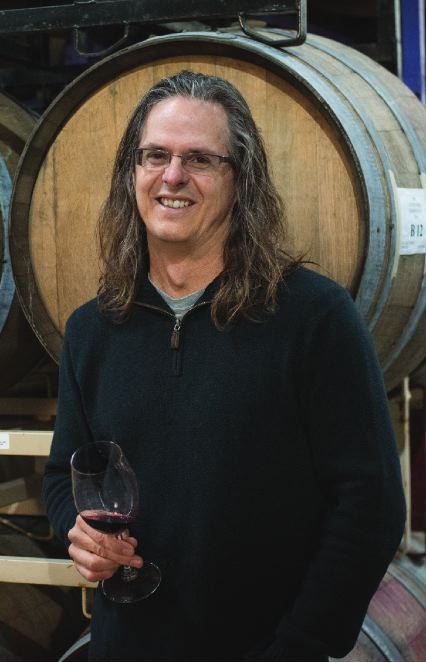 Santa Rita Hills AVA Pinot Noir was added to the J. Wilkes portfolio beginning with the 2013 vintage and released in 2015. This opportunity allowed me to use my knowledge of this area to blend a 250 case offering. In 2014, we added Paso Robles Highlands District AVA to the lineup. So far we have produced a broad market offering of Cabernet Sauvignon (the first 2014 vintage garnering 93 points) and smaller productions of Zinfandel and Lagrein from this AVA for our wine club and special accounts. The future of the J. Wilkes label is bright. The case production has nearly tripled since I came on board, and we are cementing a national footprint for J. Wilkes to be a “Wine of Place,” representing elite vineyards from a specific AVA blended together. We currently blend the best vineyards in three AVAs: Santa Maria Valley, Santa Rita Hills and Paso Robles Highlands District. My greatest hope is that Jeff would enjoy the wines our team produces, and find them a solid reflection of the wines he loved to drink and make. Please raise a glass of Pinot Noir or Pinot Blanc to the legacy of Jeff Wilkes tonight and maybe even spill a drop into the Pacific Ocean in his memory. I think Jeff would be pleased that to this day, Pinot Blanc is our top selling wine in the United States and beyond. For those who never met Jeff, I offer a short video of him with his barrels at CCWS (thanks to Lee Tomkow): www.youtube.com/watch?v=jUOnrggLf6k.
Wes offers private and semi-private wine tasting on occasions for wine club and committed enthusiasts (see website). A tasting room is planned for opening in late fall 2018. J. Wilkes wines are available from the winery website at www.jwilkes.com as well as through retail distribution. These are among the best wine values currently in California.
2015 J. Wilkes Santa Maria Valley Pinot Noir 14.3% alc., pH 3.72, TA 0.655, 2,021 cases, $30. · Moderately light garnet color in the glass. Inviting aromas of dark cherry, blueberry, cola, exotic spice, underbrush and seasoned oak. Light to mid weight in style, with a silky demeanor and an earth-driven core of black cherry fruit. A whisper of toasty oak plies the background, the tannins are easygoing, and there is some finishing drive. Considerably more enjoyable when tasted the following day from a previously opened and re-corked bottle. Score: 91
2016 J. Wilkes Santa Maria Valley Pinot Noir 13.9% alc., pH 3.79, TA 0.54, 500 cases, $30. · Moderate garnet color in the glass. Fruit aromas of cherry and raspberry are accompanied by hints of toast and vanillin. A middleweight style that is both delicate and refined, featuring the essence of red cherry. Noticeable juiciness, with a sleek mouthfeel, modest tannins, and a thread of oak in the background. Score: 91
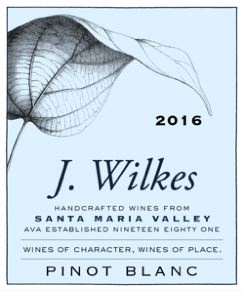 2016 J. Wilkes Santa Maria Valley Pinot Blanc 13.9% alc., pH 3.30, TA 0.697, 800 cases, $18. Sourced from the oldest Pinot Blanc vines (and a few Melon de Bourgogne) in California. · Light golden yellow color in the glass. Dreamy aromatics featuring white peach, pear, banana, spice, white flower blossom and pastry cream. The flavors replicate the aromas with an added bit of lemon-lime. Bright, but integrated acidity, slight creaminess in texture, and finishing with lip-smacking, cleansing goodness. A consistently fine aromatic white wine, scoring annually in the 90-93 range and one of the best examples of this varietal that I have ever encountered. Score: 92
Pinot Blanc is a white grape genetic mutation of Pinot Noir. Research has indicated that this mutation of Pinot Noir arose independently from the ancestral Pinot Noir, suggesting a novel parallel evolutionary model. Pinot Blanc is fairly widely planted worldwide, but has never received the attention accorded other major white varieties. Stateside, the most plantings are in the Willamette Valley of Oregon where it has not achieved the notoriety of Pinot Gris. That said, I have had a number of exemplary Pinot Blancs from that region. Many examples of Pinot Blanc are driven by subtlety, sometimes to the point of blandness, giving the wine a bad rap. It probably has garnered its most notoriety from examples grown in northern Italy and Alsace. Its flavor profile mimics Chardonnay, but is lighter and less assertive. It is often confused with Chardonnay as it is frequently vinified in a similar style, sometimes even using barrel fermentation and malolactic fermentation. It can also be vinified in stainless steel. New World styles of Pinot Blanc can thus range from a bright, crisp, mineral-driven and timid style fermented in stainless steel to a wine resembling a fat, creamy Chardonnay. Do not confuse Pinot Blanc with Pinot Noir Blanc. A white wine can be produced from Pinot Noir if the grapes are pressed without skin contact after harvesting since the pulp and juice of the Pinot Noir grape are clear. The resulting wine is the essence of Pinot Noir grape juice or Pinot Noir Blanc.
Lynmar Estate: Russian River Valley Pinot Noir & Chardonnay Standard-BearerLynmar is a well-established winery that was founded in 1990 and released its first wines from the 1994 vintage. Lynn Fritz purchased the Quail Hill Vineyard in the Russian River Valley ten years prior to the founding of the winery. The winery was modest in scale initially but the Pinot Noir wines were very well received. In 2004, the winery launched a five-year plan to do a phased replanting of 71% of the 47-acre Quail Hill Vineyard. Today, the vineyard is planted to about 70% Pinot Noir (14 clones) and 30% Chardonnay. A small block of old vine Swan selection planted in 1974 was retained. Quail Hill Vineyard is located in one of the cooler areas of the Russian River Valley, exposed to cooling influences from the Petaluma Wind Gap and the nearby Laguna de Santa Rosa, a large complex of freshwater wetlands. The soil is Sebastopol sand loam possessing an ideal pH and drainage quality for Pinot Noir and Chardonnay vines. The photo below shows Quail Hill Vineyard with typical Russian River Valley fog intrusion in December.
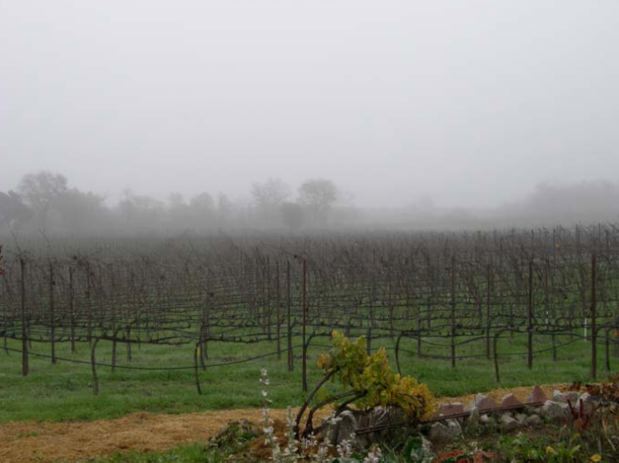 More recently, an impressive new winery with caves for barrel storage and a hospitality center was added. The tasteful tasting salon overlooks the estate vineyard and an extensive garden. For years the hospitality center was open daily to the public, but it became so popular, visits had to be restricted to an appointment schedule. Lynmar Estate was one of the pioneers in combining wine tasting with food pairing and the winery has had its own chef, David Frakes, for many years. The hospitality center is pictured below.
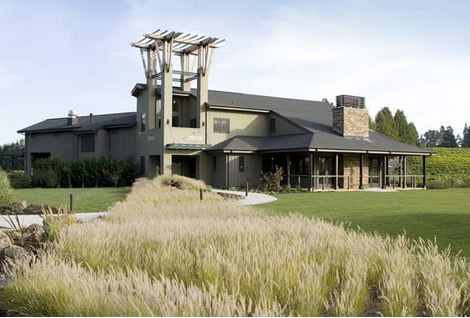 Lynmar has a long history of excellent winemakers. Hugh Chapelle and consulting winemaker Paul Hobbs were instrumental in establishing the world-class status of the wines. Noted viticulturist Greg Adams has contributed to the lofty accolades for this winery as well. More recently, Bibiana Gonzalez Rave replaced Chapelle, and left for Pahlmeyer in 2012. Shane Finley, who gained his skills at Kosta Browne, continued the winery’s reputation as a regional standard-bearer for Pinot Noir and Chardonnay. The winemaker since 2017 has been Pete Soergel, who has worked at Lynmar Estate both as an assistant and associate winemaker since 2011. He also spent three years at Kosta Browne before moving to Lynmar Estate. Shane Finley continues on as a consultant. Lynn and spouse Anisya stepped away from their international careers in 2008 and now make the Lynmar Estate their permanent home. Anisya has expanded the winery’s wine and food experiences creating a shared community of wine and food aficionados. Together, they have added contiguous parcels around Quail Hill to create a 100-acre estate. A second estate vineyard, Susanna’s Vineyard, was a gift from Lynn to Anisya. It was planted in 2006 within the Green Valley, Russian River Valley and Sonoma Coast appellations, and consists of 10 acres of Pinot Noir and 10 acres of Chardonnay. Most recently, a third estate vineyard, the 9-acre Adam’s Vineyard, was planted to Pinot Noir and Chardonnay in 2012 on a hillside in Forestville overlooking the Russian River Valley. Specifics and vineyard maps of each of the three estate vineyards are available on the winery website at www.lynmarestate.com. The Lynmar wines are virile examples of Pinot Noir that boast a rich middle palate and finish. There is significant use of new oak that adds toast and spice accents to the wines.
2016 Lynmar Estate Quail Hill Vineyard Russian River Valley Pinot Noir 14.6% alc., pH 3.57, TA 0.62, 922 cases, $65. Release fall 2018. All 14 clones in this estate vineyard including Dijon 667 and 777, Pommard, Swan, 2A and Calera are included in this signature estate blend. Aged 14 months in French oak barrels, 40% new. · Moderately dark garnet color in the glass. Vigorous aromas of Bing cherry, baking spice, cola, splintered oak and vanilla. Boldly concentrated flavors of black cherry, blackberry and cassis with a heavy dusting of toasty oak. Intense and lengthy in the mouth, finishing with plenty of sweet, dark fruit. Score: 89
2016 Lynmar Estate Monastery Russian River Valley Pinot Noir 14.2% alc., pH 3.59, TA 0.60, 465 cases, $70. Release fall 2018. This careful selection of Pinot Noir clones is meant to be a nod to the red wines of Burgundy, with a more savory and earthy character and higher acidity. Vineyard sources include Quail Hill, Kanzler, Gensler and Umino. clones 667, 115, 777, Beba and Pommard. Aged 15 months in French oak barrels, 53% new. · Dark garnet color in the glass. Pleasing aromas of well-ripened purple and black berries, with hints of nectarine, rose petal and forest floor. Definitely trends to a rustic, savory, earthy and tannic style, with a mid weight plus concentration of purple berry fruits. Silken and streamlined on the palate with a succulent, fruit-driven finish. Score: 92
2016 Lynmar Estate Anisya’s Blend Susanna’s Vineyard Sonoma Coast Pinot Noir 14.3% alc., pH 3.58, TA 0.59, 540 cases, $85. Released spring 2018. A selection of the very best barrels from Susanna’s Vineyard. This bottling is named in honor of the women of Lynmar. Aged 15 months in French oak barrels, 59% new. · Moderately dark garnet color in the glass. Much to be discovered in the nose that offers aromas of blackberry, black currant, mocha, spice, earthy flora and dark rose petal. The purple and black fruit packs a punch on the palate, extending richness through a slightly astringent finish. The sleek texture is attractive as is the superb barrel treatment. This wine is fruit-driven with little nuance, yet can be delightful to those who relish hedonistic fruit. Score: 91
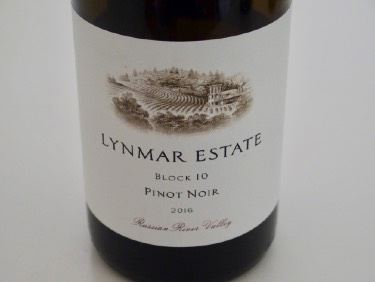 2016 Lynmar Estate Block 10 Quail Hill Vineyard Russian River Valley Pinot Noir 14.4% alc., pH 3.61, TA 0.64, $80. Released spring 2018. Dijon 667 and 777 from a single east-facing block in Quail Hill Vineyard. Aged14 months in French oak barrels, 64% new. · Moderately dark garnet color in the glass. Enticing scents of blackberry jam, bramble, and oak spice. There is no shortage of boysenberry and blackberry fruit is this mid weight plus styled wine that fills the mouth with opulence. That said, the fruit load is beautifully balanced with appropriate oak treatment. Nuances of earth and spice abound. The long finish reveals why this block has a special calling. Considerably better when tasted the following day from a previously opened and re-corked bottle. Score: 94
2016 Lynmar Estate Old Vines Quail Hill Vineyard Russian River Valley Pinot Noir 14.5% alc., pH 3.57, TA 0.60, 251 cases, $80. Released spring 2018. Swan selection planted in 1974. Aged 11 months in French oak barrels, 64% new. · Dark garnet color in the glass. Gorgeous aromas of black cherry, ripe strawberry and balsam. The wine floods the mouth with carnal energy, featuring flavors of black cherry and black raspberry. The wine has commendable harmony with both pleasing tannic power and uplifting acidity. There is only a dusting of oak. Somewhat more giving when tasted the following day from a previously opened and re-corked bottle, but I sense that this wine needs a few years in the cellar to reveal all of its charms. Score: 93
2016 Lynmar Estate Quail Hill Vineyard Russian River Valley Chardonnay 14.2% alc., pH 3.42, TA 0.64, 507 cases, $60. Release fall 2018. A blend of old vine Rued clones planted in 1971 and more recent plantings of Old Wente selections. Aged 14 months in French oak barrels, 55% new. · Moderately light golden yellow color in the glass. A very outgoing wine, offering waves of cut yellow apple, lemon curd, pineapple, nectarine, floral, musk and buttered toast aromas. Creamy on the palate, with delicious flavors of yellow apple, pineapple, tropical fruits and toasty oak. A sybaritic wine, yet possessing enough acidity to energize the palate. Score: 93
2016 Lynmar Estate Susanna’s Vineyard Sonoma Coast Chardonnay 14.2% alc., pH 3.44, TA 0.63, 903 cases, $60. Release fall 2018. Aged 15 months in French oak barrels, 74% new. · Moderate golden yellow color in the glass. Shy, but pleasant aromas of lemon oil, pineapple, white flower blossoms, spice and seasoned oak. Not as outgoing or flamboyant as the Quail Hill bottling, but more refined and high collar, offering flavors of citrus, toast, and spice. Impressive intensity of flavor and length on the extended finish. You need to relish oak to fully embrace this wine. Score: 92
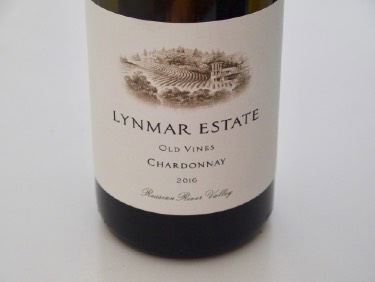 2016 Lynmar Estate Old Vines Russian River Valley Chardonnay 14.1% alc., pH 3.46, TA 0.64, 183 cases, $70. Release winter 2018. Rued clone grown on 40-yer-old vines on a single block in the Quail Hill Vineyard. 24-hour cold soak on the skins prior to pressing off the juice. Aged 13 months in French oak barrels, 50% new. · Moderately light golden yellow color in the glass. Leading the appeal are aromas of lemon pie, caramel, parchment, toast and musk. Noticeably vibrant in the mouth with the invigorating flavor of lemonlime. This wine has a character all its own that challenges proper description. Just leave it as classy, juicy, and harmonious. Score: 94
2016 Black Kite Cellars: Sumptuous Pinot NoirsBlack Kite Cellars was originally founded to showcase the individual Pinot Noir blocks that comprise the Green family’s 12-acre Kite’s Rest Vineyard in Anderson Valley. These three latest block releases are among the best wines produced to date from this vineyard, offering bold extraction, ripe fruit and firm tannins, yet appealing balance. These are not demure, timid Pinot Noir wines, but they offer the whole package of hedonistic delight true to the Black Kite Cellars style and in this vintage display impeccable harmony. The wines were aged in a significant percentage of new oak, yet one never thinks of oak in tasting these wines. Black Kite Cellars wines are available through the winery at www.blackkitecellars.com, as well as through distribution in select wine shops and restaurants nationally.
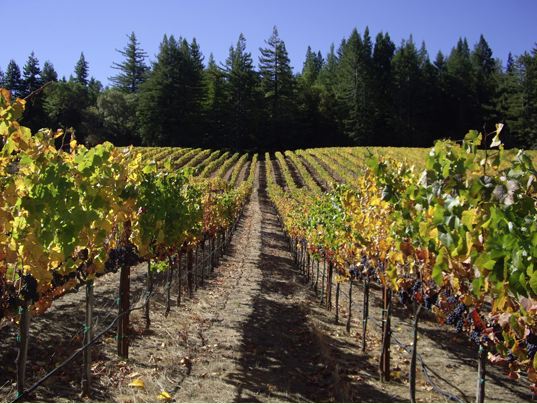
2016 Black Kite River Turn Block Anderson Valley Pinot Noir 14.6% alc., pH 3.40, TA 0.67, 131 cases, $60. Pommard clone. Aged 18 months in French oak barrels, 66% new. · Moderately dark garnet color in the glass. Aromas of ripe black fruits, seared beef, black olive and fertile earth. A mid weight plus styled wine with a deliciously rich core of blackberry, black raspberry and cassis flavors supported by subtle oak flavors. Despite the stunning fruit load, the wine is light on its feet with firm, but needed tannins and complimentary acidity. The finish is noticeably extended. Still fat and lush when tasted the following day from a previously opened and recorked bottle. This wine shows the most oak of the three block wines tasted, yet the barrel treatment is not unduly aggressive. Score: 93
2016 Black Kite Stony Terrace Block Anderson Valley Pinot Noir 14.5% alc., pH 3.55, TA 0.64, 132 cases, $60. Pommard clone. Aged 18 months in French oak barrels, 66% new. · Moderately dark garnet color in the glass. The nose features ripe, black fruits along with noticeable gravelly “minerality.” Prodigious purple and black fruits flood the mouth with goodness, backed by bold tannins in a mid weight plus style. The wine builds in appeal over time in the glass and when tasted the following day. The seamless finish is gloriously long. Score: 94
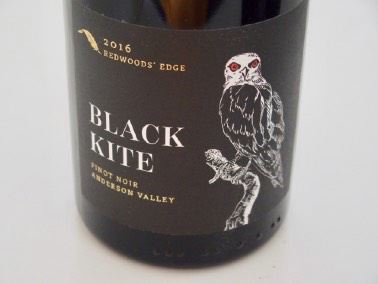 2016 Black Kite Redwood’s Edge Block Anderson Valley Pinot Noir 14.5% alc., pH 3.50, TA 0.64, 132 cases, $60. Dijon 114 and 115 clones. Aged 18 months in French oak barrels, 66% new. · Moderately dark garnet color in the glass. Deep aromas of dark cherry and blueberry-pomegranate. The mid weight plus palate of long and powerful black fruits are framed by integrated bold tannins. There is a nice complement of grilling spice flavor with a deft kiss of oak. The finish is blissful and lengthy and the balance is flat-out impeccable. Extremely seductive when tasted the following day from a previously opened and re-corked bottle, again showing off gracious harmony. Score: 95
2016 Black Kite Gap’s Crown Vineyard Sonoma Coast Chardonnay 14.4% alc., pH 3.44, TA 0.61, 140 cases, $58. Dijon clones 76, 95, and 96. Aged 18 months in French oak barrels, 66% new. · Moderate golden yellow in the glass. This is an oak-inspired Chardonnay offering aromas of toast and brioche along with pineapple, lemongrass and honey. Richly fruited and intensely flavored, offering tastes of pineapple, yellow apple, tropical fruits and a bit of oak-driven toast and coconut. The fruit assaults the palate with purpose, yet the experience benefits from adequate acidity. The mouthfeel is slight viscous and comforting. This wine is a dead ringer for the Aubert style of very expensive Chardonnay that many Chardonnay lovers are enamored with. Score: 92
Recently Tasted Willamette Valley Pinot Noir
Arterberry Maresh, Dundee Hills, ORThe Maresh family has had a long and historic presence in the Dundee Hills of Oregon. Jim and Loie Maresh were Wisconsin natives who met as students at Marquette University. The couple bought a 26-acre farm in the Dundee Hills on Worden Hill Road in 1959. They expanded their holdings to 140 acres while Jim worked for Dunn & Bradstreet and served as a reserve naval officer in Portland. Their home was the first on the hill, and they enjoyed the life of farming cherries, nuts and prunes. By the late 1960s, after David Lett had planted the first Pinot Noir vineyard in Yamhill County, Dick Erath suggested to the Maresh family that they had a superior site for growing wine grapes. In 1970, they followed his suggestion and planted three acres of vines, This was the first vineyard of many to come on Worden Hill Road and became Oregon’s fifth oldest vineyard. In the photo below of Maresh Vineyard, note the red, volcanic (Jory) soils typically found in the Dundee Hills.
 Jim and Loie had five children. One daughter, Martha, married Fred Arterberry who was one of the first Oregon winemakers to have a degree from UC Davis. Arterberry was well-known in wine circles in Oregon and produced many award-winning wines. Martha and Jim had a son, Jim Arterberry Maresh. The Maresh estate now consists of 124 acres of Pinot Noir and Chardonnay. About half of the grapes were historically vinified as Red Barn Pinot Noir, named after the red barn on the property. This wine was made by several winemakers through the years and sold only through the Red Barn tasting room. The remainder of the grapes were sold to prestigious wineries throughout the Willamette Valley who often bottled Marsh Vineyard-designated Pinot Noir.
 Jim Arterberry Maresh began his winemaking career at an early age, and by 2011 when he was 25-years-old, he had been touted as Oregon’s “Best Young Winemaker.” His father’s label, Arterberry Cellars, had disappeared when Fred died. Jim had begun making wine in 2001 as a teenager and by 2007 had revived the label as Arterberry Maresh, releasing his inaugural wines from the 2005 vintage. He was among the first to represent a third generation in Oregon’s wine industry. Jim crafts his wines in the family’s Powell Hill Winery on the Maresh property, named after the original family that farmed the land. He draws grapes from his grandfather’s non-irrigated vines at Marsh Vineyard as well as several other highly-regarded vineyards in the region. His signature Pinot Noir is from own-rooted, old-vine Pommard and Wädenswil vines at Maresh Vineyard. Tastings with winemaker Jim Maresh are available Monday to Thursday by appointment. The wines are released in the spring and fall and sold to a mailing list with limited retail store distribution. Visit the website at www.arterberrymaresh.com.
2015 Arterberry Maresh Maresh Vineyard Dundee Hills Willamette Valley Pinot Noir 14.0% alc., $59. Bottled unfined and unfiltered. · Moderately light garnet color in the glass. Leading off are aromas of black cherry, pomegranate, rose petal and sawdust. Ripely fruited as befits this warm vintage, this mid weight plus styled wine has layers of black cherry and blackberry fruits. Big and ripe by Oregon standards, but still quite satisfying with a silky mouthfeel, mild tannins and an agreeable finish. Score: 92
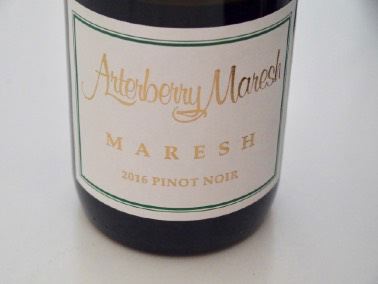 2016 Arterberry Maresh Maresh Vineyard Dundee Hills Willamette Valley Pinot Noir 12.8% alc., $69. Bottled unfined and unfiltered. · Moderately light garnet color in the glass. Lovely aromas of cherry, strawberry, rose petal and underbrush. The wine’s brightness and purity of red berry and red cherry fruit is very appealing. The fruit is beautifully supported by righteous tannins and crisp acidity, making for seamless drinking. A delightful grip of cherry on the finish reminds of the Dundee Hills origin of this exceptional wine. Even more enchanting when tasted the following day from a previously opened and re-corked bottle. Score: 95
2016 Arterberry Maresh Maresh Vineyard Old Vines Dundee Hills Willamette Valley Pinot Noir 12.8% alc., $42. Bottled unfined and unfiltered. · Moderate garnet color in the glass. Boastful aromas of red cherry, strawberry, underbrush, herbal oak and a hint of iron. Dark red fruited in a mid weight style with an underlying earthiness. The fruit is ideally ripened with a superb richness on the middle palate. What really stands out in this wine is the finish that is satiny smooth and uncommonly persistent. This special wine is more giving when tasted the following day from a previously opened and re-corked bottle indicating age worthiness. Score: 94
Bow & Arrow, Portland, ORScott Frank, who had a varied career, including a stint as a grocery store wine buyer in Portland, and learned his winemaking at Cameron Winery, started his own label in 2011. He explores the wines of the Willamette Valley paying homage to the “refreshing and decidedly working class wines of France’s Loire Valley.” Visits and tastings at the winery are by appointment ($25 per person). Visit the website for inquiries at www.bowandarrowwines.com. These are opulent wines reflecting the warm 2015 vintage. They offer far to much oak for my personal preference, but are otherwise pleasing in fruit goodness. The ABV of the wines doesn’t match the phenolic ripeness of the fruits which is puzzling.
2015 Bow & Arrow Vitae Springs Vineyards Willamette Valley Pinot Noir 12.5% alc., $28. Aged in barrique for 10 to 12 months. · Moderately dark garnet color in the glass. The nose is redolent of aromas of cherrywood, cardamom spice and burnt tobacco. The mid weight plus core of black cherry and boysenberry fruits shows a good attack and length on the palate with some finishing persistence. Sleek in texture, with vibrant acidity, complimentary tannins and a noticeable infusion of oak. Score: 88
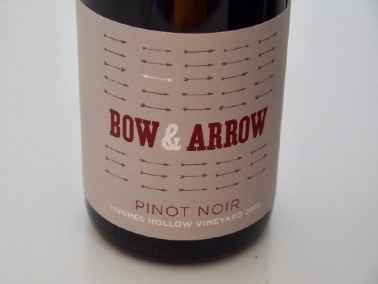 2015 Bow & Arrow Hughes Hollow Vineyard Willamette Valley Pinot Noir 12.5% alc., $29. An interesting story behind this vineyard. Originally planted 30+ years ago on a north-facing slope, it was not given a name and was used by large production houses for color and bulk. Bow & Arrow winemaker Scott Frank convinced the owner to switch to organic farming and sell him the Gamay block planted on the site. Pinot Noir became part of the deal grudgingly, but it has turned out that this is the best source of Pinot Noir that Frank has worked with. Dry farmed vines. · Moderate garnet color in the glass. Aromas of fresh cherry, oak spice and burnt tobacco. Generous mid weight flavors of purple and black berries that charm the palate through a noticeably long finish. The tannins are well-matched, and there is a modest oak contribution. This wine is more appealing than the Vitae Springs bottling and has a much longer finish. Score: 90
Broadley Vineyards, Monroe, ORReaders know that I have reviewed the excellent Broadley Vineyards Pinot Noirs crafted by Morgan Broadley for a number of years and consider them among the best in Oregon. The wines have made my All-American lists several times. The 33-acre estate vineyard is planted to a mix of Pommard, Wädenswil and Dijon clones of Pinot Noir and divided into blocks. Winemaking employs a significant percentage of whole cluster fermentation and unique wood cask fermentation. The winery is located in a former car dealership in Monroe with tasting available at that location by appointment. Wine is also crafted in McMinnville. The winery is a bit out of the way and takes some driving to visit, but is worth the effort. Visit www.broadleyvineyards.com. Monroe is a southern outpost in the Willamette Valley with few wineries in the area. Broadley Vineyards is the anchor winery of the area, having been established by the Broadley family back in 1982. The area is undergoing a makeover however. This quaint wine country town recently formed a beautification committee that will try to highlight Monroe’s tourist draws while preserving its agriculturally-focused charm. A new brewery is in the works, along with a boutique hotel and farmer’s market. Broadley Vineyards is paying homage to the updates with a new label called “Starr Point.” The label is named after the original settlement (later named Monroe) and conceived in celebration of the area’s steamboat traffic over a century ago. The label will be available to the public with newly-released wines this November.
2017 Broadley Vineyards Willamette Valley Pinot Noir 13.5% alc., 2,200 cases, $22. Sourced from several vineyards in the Willamette Valley. 100% de-stemmed. Fermented for 10-14 days in open-top stainless steel and plastic bin fermenters. Aged 9-10 months in neutral oak barrels. · Moderately light garnet color in the glass. Aromas and flavors of black cherry and strawberry in a rustic style with a note of savory herbs in the background. Simple, with mild dry tannins, made in an easily approachable package. Score: 88
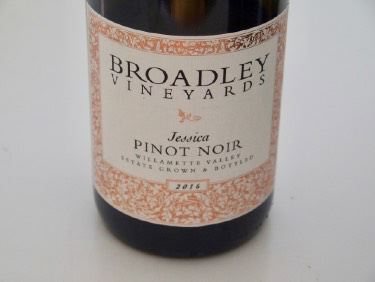 2016 Broadley Vineyards Jessica Willamette Valley Pinot Noir 13.8% alc., $50. Named for Morgan Broadley’s wife and partner in Broadley Vineyards. Produced from Dijon 667 and 115 clones on the estate vineyard surrounding the Broadley’s home. Wild yeast fermentation, significant percentage of whole cluster. Fermented in 5-ton French oak open-top wooden fermenter for 14-21 days. Aged n14-18 months in French oak barrels. · Moderate garnet color in the glass. The aromas blossom beautifully over time in the glass, offering notes of darker cherry, boysenberry, violets and a hint of beneficial nutty and vanillin oak. Very suave in the mouth with gracious, silken tannins, becoming more engaging with time. Middleweight in concentration, with well-bred, saucy flavors of black cherry and black raspberry. Enviable balance, with lasting flavors on the finish. Irresistible when tasted the following day from a previously opened and re-corked bottle. Score: 94
Winter’s Hill Estate, Dayton, ORLocated among many noted wineries in the Dundee Hills such as Domaine Serene, Stoller and The Eyrie Vineyards, this winery does not receive the recognition that it deserves. The estate vineyard was planted to 12 acres of own-rooted Pinot Noir in 1990 on a south-facing slope. The second phase of planting began in 1997 on phylloxera-resistant rootstocks, with Pinot Noir plantings of Pommard, Wädenswil, 114 and 115 clones, Pinot Gris and Pinot Blanc now totaling 35 acres. The vineyard is LIVE certified sustainable. Delphine Gladhart, the daughter-in-law of Peter and Emily Gladhart, who founded the winery and planted the original vineyard, was the winemaker until 2014, when she passed the reigns to her spouse Russell. Russell has worked in Oregon and New Zealand and studied enology and viticulture in Burgundy. Russell, Emily and Peter are pictured here.
 The tasting room is one of the friendliest in the Willamette Valley according to Trip Advisor. Several tasting options are offered at Winter’s Hill Estate where you will almost always be greeted by one of the owners. Visit www.wintershillwine.com for more information.
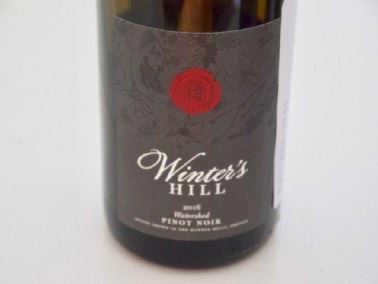 2016 Winter’s Hill Watershed Dundee Hills Willamette Valley Pinot Noir 13.5% alc., 800 cases, $25. Fall 2018 release. · Moderately light garnet color in the glass. Exalted nose that really caught my attention with aromas of dark cherry, purple berry and burnt tobacco. Light to mid weight in style, with a captivating core of black cherry fruit. Sleek and polished, seamless and revealing, with a quenching finish that leads the drinker to take another sip. Even better when sampled the following day from a previously opened and recorked bottle. Quintessential Willamette Valley Pinot Noir and a great value to boot. Score: 93
2016 Winter’s Hill Dundee Hills Willamette Valley Pinot Noir 13.8% alc., 317 cases, $39. The winery’s flagship selection that includes 100% estate fruit. · Moderately light garnet color in the glass. Persistent aromas of fresh strawberry, cranberry, blueberry, iron and mulling spices. Fresh and juicy in the mouth, with charming mid weight flavors of strawberry, raspberry and blueberry. The gossamer tannins add to the appeal as does the lengthy, lip-smacking finish. Score: 92
2016 Winter’s Hill Single Block Series Block 9 Pommard Dundee Hills Willamette Valley Pinot Noir 13.8% alc., 73 cases, $49. Fall 2018 release. · Moderate garnet color in the glass. Aromas of Bing cherry, grilled mushrooms and shaved oak. Deeply-flavored essence of dark red cherry and berry offering an intense attack and middle palate presence. Well-crafted, with integrated tannins and plenty of finishing goodness. Score: 91
2016 Winter’s Hill Single Block Series Block 10 Dundee Hills Willamette Valley Pinot Noir 13.6% alc., 73 cases, $49. Release fall 2018. 100% de-stemmed. · Light garnet color in the glass. Nicely perfumed with aromas of raspberry, cherry and toasty oak. Lighter-weighted in a teasing, demure style with flavors of cherry and red berry. Silky, refined and feminine in character, with the slightest fine-grain tannins and some length in the mouth. Hard to criticize, but pretty straightforward. Score: 89
13.7% alc., 73 cases, $49. Fall 2018 release. · Moderate garnet color in the glass. Haunting aromas of dark cherry, spice and burnt tobacco. This wine offers significantly more concentration than the 100% de-stemmed version with a darker fruit profile, somewhat more tannins, and a very slightly astringent finish. That said, I find it more appealing for its black cherry, spice and tobacco flavors as well as its seductive texture. I am a whole cluster junkie and my score reflects that preference in comparison to the de-stemmed version of this wine. Score: 92
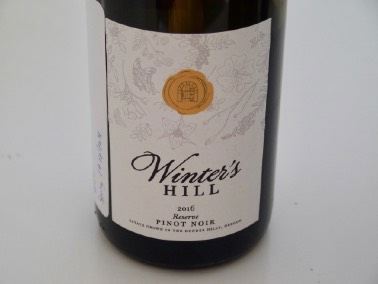 2016 Winter’s Hill Reserve Dundee Hills Willamette Valley Pinot Noir 13.8% alc., 195 cases, $65. Release spring 2019. A selection of the finest blocks of the estate vineyard. · Moderate garnet color in the glass. Engaging aromas of black cherry, raspberry, spice and earthy flora. Packing plenty of black cherry, black raspberry and spice flavors, the pretty fruit load is reigned in by compatible tannins and acidity. The finish is remarkably long. A classy wine built for aging that will need another couple of years in the cellar to completely come out of its shell (although you can drink it now). This wine is deserving of the Reserve label. Score: 94
Another Picpoul Blanc Surfaces from Anaba WinesI recently wrote about an offbeat white wine grape variety that grabbed my attention: Picpoul Blanc at www.princeofpinot.com/article/2095/. I subsequently found out that Anaba Wines in Sonoma produced a Picpoul Blanc from Snow Vineyard in the Sonoma Valley in 2017. The wine was crafted by the winemaking team of Ross Cobb (COBB Wines) and Katy Wilson (LaRue), who make all of the Anaba wines. This wine turned out to be an outstanding example of this varietal as well. Obtain the wine at www.anabawines.com.
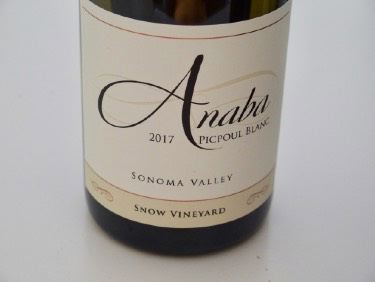 2017 Anaba Snow Vineyard Sonoma Valley Picpoul Blanc 12.0% alc., pH 3.36, TA 0.56, 169 cases, $28. This vineyard is located just a few miles from Sonoma Plaza. The warm days and cool evenings provide ideal growing conditions for Picpoul Blanc. Harvest Brix 20.0º. Pressed immediately after harvesting into a stainless tank where it was racked off the lees post settling. 100% stainless steel aging. Bottled in February 2018. · Light golden yellow color in the glass. Beautifully perfumed with aromas of yellow apple, honey and brioche. Bright and clean on the palate, with flavors of pear, honey, apple, and a hint of vanilla. Highly enjoyable with an uplifting, soprano finish. Score: 92
Pinot BriefsBottle of 1945 DRC Romanée-Conti Sells for $558,000 at Christie’s Auction Bottles of DRC from the personal cellar of Robert Drouhin in Burgundy were recently auctioned. A bottle of 1945 Romanée-Conti went for $558,000 including the buyer’s premium and taxes and a second bottled brought $496,000. DRCs original plantings on their own roots were pulled out after the 1945 vintage. Only 600 bottles of DRC Romanée-Conti were produced in 1945. I had to laugh because I thought back several years when, on my 50th birthday, I opened a bottle of 1943 (my birth year) DRC La Tâche for my wine buddies. It had been given to me by a friend who paid $2,500 a few years prior! The label and cork seemed to confirm its provenance and the wine was glorious. A number of years before that, I bought a 6L bottle of 1983 DRC La Tâche at auction for $900! Admittedly, this was not a stellar vintage, but it shows how much prices for DRC wines have escalated over the past 30 years.
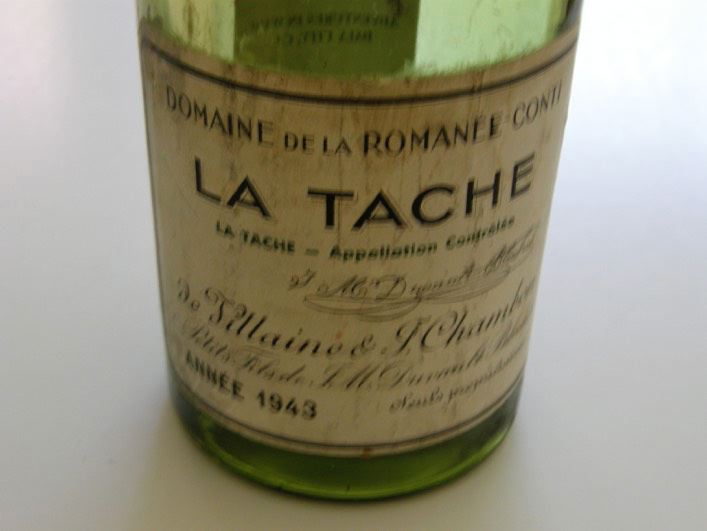 Best 2018 Champagnes FINE Champagne magazine, the only international publication devoted to champagne and tastingbook.com, the world’s largest wine information source, recently announced their list of the ‘100 Best Champagnes for 2018. Hundreds of champagnes were blind-tasted for this competition. The top champagne for 2018 was the 2006 Dom Pérignon Rosé. The first vintage of this wine, 1959, was launched in 1971. Said to be truly Burgundian in character, it is known for its aromas and structure. The cellar master, Richard Geoffroy said 2006 was his most challenging vintage, a hot and dry year. Runner-up was the 2002 Piper-Heidsieck Rare. Rounding out the top 10 were the 2004 Dom Ruinart Rosé, 2008 Dom Pérignon, 2009 Louis Roederer Cristal, 2006 Deutz Cuvée William Deutz, 2008 Pol Roger Rosé, NV Krug Grande Cuvée (162nd Edition), 2006 Charles Heidsieck Vintage Rosé and 2004 Charles Heidsieck Blanc des Millénaires. French-Chinese Wine Lab to Deal With Climate Change According to thedrinksbusiness.com, a new research lab, Innogrape, has been established by France and China that will employ 30 researchers and scientists to look into creating new grape varieties and rootstocks, and focusing on berry maturation mechanisms that are better adapted to climate change. The idea is to share expertise about selecting vines that are resistant to diseases like mildew, phylloxera, drought and extreme temperatures. 2019 World of Pinot Noir Tickets on Sale The 2019 event features more than 250 wineries from around the world, seminars, Pinot Noir parties and wine pairing dinners. Early Bird pricing is now available through October 31 for Weekend Passes and the Grand Tastings on Friday and Saturday. The event will take place February 28-March 2 at the Ritz-Carlton Bacara in Santa Barbara. For details on the individual events and to purchase tickets, visit www.wopn.com. R. Stuart & Co. Winery Acquires First Estate Vineyard Daffodil Vineyard, a 21-acre site in the Eola-Amity Hills of the Willamette Valley was purchased by Rob and Maria Stuart. The vineyard was planted in 1997 by founders Judy Phipps and Phil Mickelson and features Pinot Noir rooted in Jory soil. Winemaker Rob Stuart has a fifteen-year history with the vineyard. St. Innocent Moves to a New Location Thirty years after the founding of St. Innocent by winemaker Mark Vlossak, the winery located outside of Salem, Oregon has moved to a new site. The new tasting room and vineyard are located on an old poplar farm south of Willamette Valley Vineyards. Construction of a new production facility is on the way and expected to be completed this winter. Upcoming Willamette Valley Wine Events The annual ¡Salud! Pinot Noir Auction will be held November 9-19, 2018. Unfortunately, tickets are now sold out and a wait list has been set up. Bids can still be placed for the special cuvées at www.saludauction.org. Wine Country Thanksgiving in the Willamette Valley is celebrating 36 years. More than 130 participating wineries and tasting rooms welcome guests to special tastings, unique food pairings, live music, and more November 23-25, 2018. Duck Pond Sold Great Oregon Wine Company (owned by Integrated Beverage Group) purchased Duck Bond Cellars in Dundee. The sale includes the winery, tasting room and 300 acres in the Willamette and Umpqua valleys. Duck Pond is Oregon’s ninth largest winery. Wineries in the United States:
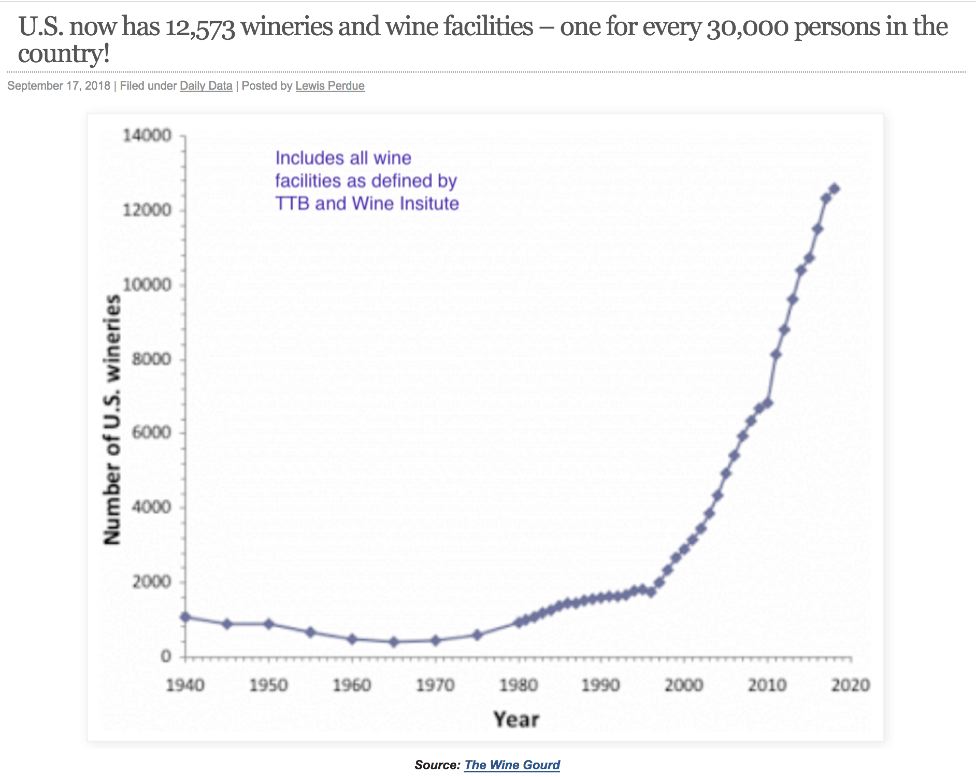 Wine & Spirits Top 100 Wineries 2018 United States wineries specializing in Pinot Noir that were in the Top 100 included Anthill Farms, Bergstrom, Big Basin Vineyards, Buena Vista, Cristom, Drew, Evening Land Vineyards, Hirsch, King Estate, Lingua Franca, Melville, Radio-Coteau, Roederer Estate, Rose & Arrow, Walter Scott, Williams Selyem and The Withers. The Family Coppola Acquires Vista Hills Vineyards in the Dundee Hills The Family Coppola has expanded its vineyard holdings beyond the Russian River Valley, Anderson Valley and Sta. Rita Hills by the acquisition of Vista Hills located near the top of the Dundee Hills AVA. Existing staff and partners of Vista Hills will be utilized to ensure a natural transition following the sale. Dave Petterson will remain as winemaker and report to Corey Beck, Chief Winemaker of The Family Coppola.
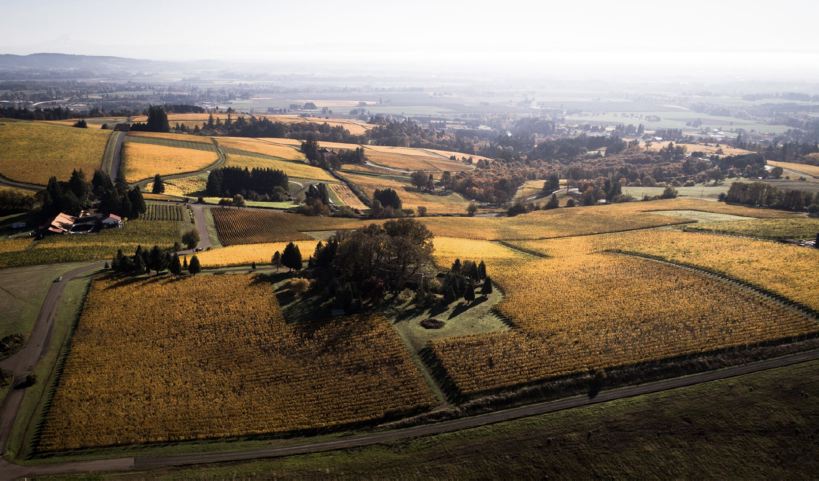 Adam Lee’s New Wine Company Clarice Released First Pinot Noir Wines As I reported previously in the PinotFile, Adam Lee sold his Siduri label to Jackson Family Wines in 2015, yet stayed on as consulting winemaker. He launched a new wine company, Clarice, based on an innovative idea combining a wine community with wine education as part of Pinot Noir wine production. 625 consumer subscribers were asked to pay $965 a year for a case of his Pinot Noir without previewing the wines beforehand, Those who sign up, also get access to a website where Lee will post articles that appeal to wine geeks. The website will also have a private forum to exchange information. Lee will also host a few parties each year where members can meet the growers and taste barrel samples. Three 2017 Santa Lucia Highlands Pinot Noirs have been released and were scored highly the Wine Advocate . Subscriptions for the 2018 Clarice wines will be available in February 2019. For information, visit www.claricewinecompany.com. Type of Alcoholic Beverage Most Often Favored by Americans Who Drink: 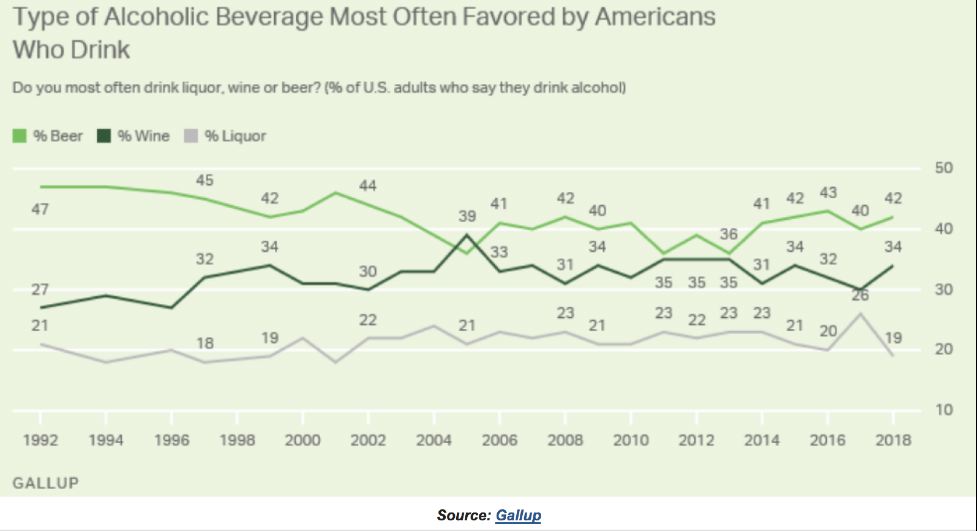 Walmart, Kroger & Target Enter the Value Price Wine Race This year, Walmart began offering 10 private-label “Winemakers Selection” wines from California, France and Italy for $11 a bottle. No Pinot Noir yet. Target introduced the California Roots brand in 2017 priced at $5. A rosé under the Yes Way Rosé label was offered in 2018 priced at $12.99. No Pinot Noir yet. Kroger sells 89 different lines of wines including the exclusive Storyteller brand and is trying home-delivery service in some markets. Some of the brands include 19 Crimes, Love Noir, Prophecy, Dreaming Tree and Outlier that Target also carries. Costco, which sells $2 billion a year worth of wine, is offering more wine options under the Kirkland Signature label. And, of course, there are Trader Joe’s Charles Shaw value-priced wines, no longer priced at two bucks, and still shunned by the wine cognoscenti. The Kitchen Winery Today’s Wall Street Journal had a special supplement on “The Future of Everything.” An article that caught my eye was titled, “The Countertop Winery - What if you could make wine by putting grapes in a bag and pushing a button? Meet the GOfermentor, an automated, spill-proof, kitchen-size vino machine.” Gofermentor Junior is a countertop machine the size of a small trash can that allows one to produce wine in a series of odorless, biodegradable plastic bags. The device will be on sale in 2019 for $500. Invented by biotech scientist Vijay Singh who became interested in a sustainable winemaking system that could be simplified and less messy than traditional winemaking. Every step of the winemaking takes place in medical-grade plastic bags that are biodegradable. No tanks or barrels needed. No waste water produced. Almost no environmental imprint. Since there is no oxygen permeating the system, sulfites are not needed for preservation. Wines have been produced by Vijay and his spouse Meera under the Sky Acres Winery label and in 2015 they took home gold, silver and bronze medals at the San Francisco Chronicle Wine Competition. The commercial version of the device is about the size of a washing machine (pictured below) and costs $2,400. For more information, visit www.gofermentor.com.
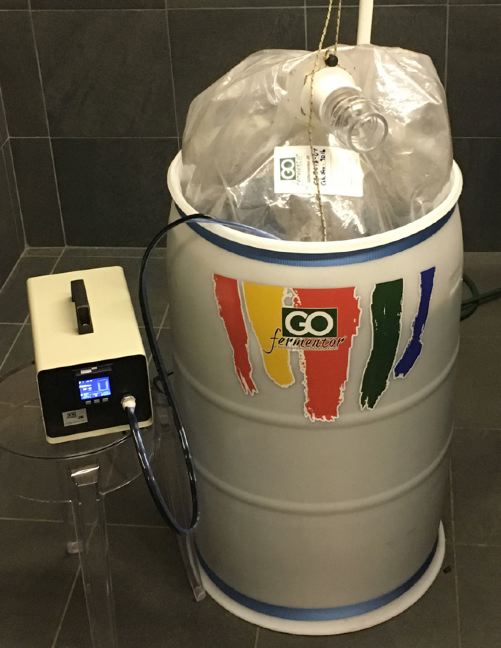 Storing Wine Horizontally in the Cellar May be A Bad Idea An article appeared at Times of Malta - https://www.timesofmalta.com/articles/view/20181026/food-drink/the-unsettling-story-of-an-uprightwine- bottle.692550 - titled, “The Unsettling Story of an Upright Wine Bottle.” Usually, wines are stored sideways to keep the cork moist and swollen and reduce the chance of air getting inside the bottle. There is universal agreement about this. The author of this article, Georges Meekers, points out that Miguel Cabral, the R&D Director at cork manufacturer Amorim, says that storing wine bottles on their side makes no difference in regard to the moistness of the cork. If anything, it may hasten the deterioration of a cork by weakening the cork’s cell structure. Cabral said, “The ullage of a sealed bottle is so saturated with moist vapor that there is no need to place it horizontally to keep the cork wet.” The high humidity inside the neck of the bottle keeps the cork moist and the ambient temperature outside the bottle has no influence on the moistness of the cork. This is not the last word on this subject as another noted winemaker told me that wine should be stored horizontally so that the cork doesn't dry out. Higher Prices for Oregon Wine May be Coming Oregon Governor Kate Brown and the Oregon Health Authority are attempting to raise $830 million in new sin taxes beginning in 2019 to cover the state’s rising Medicaid costs. Consumers will pay more for cigarettes, beer and wine as a result. Oregon’s beer and wine taxes have not kept up with inflation and the state has not increased taxes on wine in 32 years. Raising the tax on alcohol alone would bring in an additional $491 million. Nearly Four-Foot Tall Wine Glasses at Costco Costco is selling giant wine glasses in the UK and Canada for $99.99. So far, no availability in the US. The wine glass is 46” tall and holds the equivalent of 25 bottles. It is handmade and mouth-blown in Poland. Top “Premium-Plus” Table Wine Brands in the U.S. Premium-Plus wine sells for at least $10 a bottle on average.
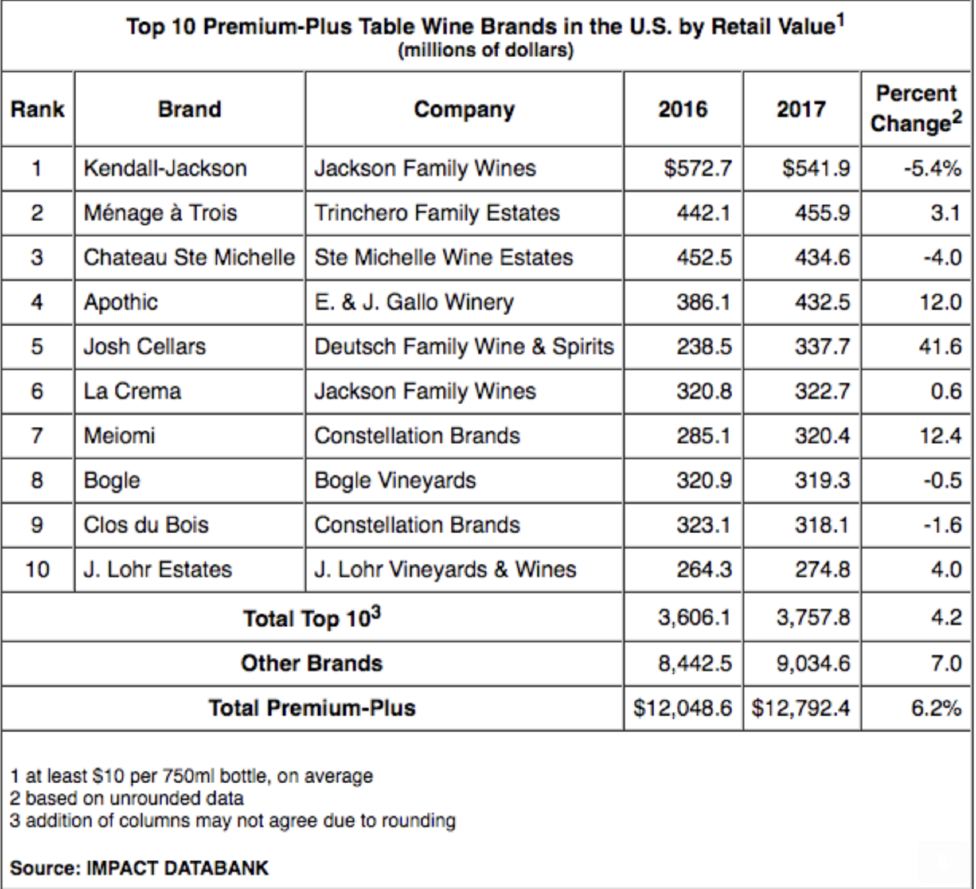
Making Sense of Wine Alcohol
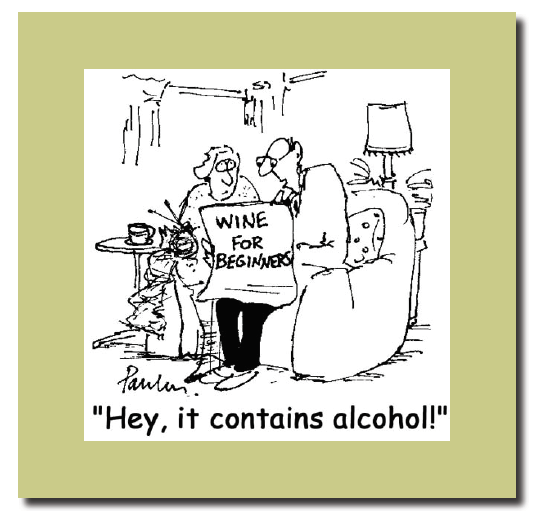 The alcohol content in wine, which is mainly ethyl alcohol, is expressed in per cent by volume of the total liquid (ABV). Brix (symbol Bx) is the measurement of the ratio of dissolved sucrose sugar to water in a liquid such as grape juice and is expressed in per cent or degrees. For example, a 25° Brix solution is 25% with 25 grams of sucrose sugar and 75 grams of water in 100 grams of solution. Knowing the Brix of the grapes prior to fermentation, the potential alcohol of the finished wine can be determined if all of the sugar is fermented. A prefermentation Brix or sugar content of 22.5° of grape juice will produce a potential alcohol (ABV) of 13.0%, 24.8° Brix will produce 14.3 %, and 25.8° Brix will produce 15.1%. The Alcohol and Tobacco Tax and Trade Bureau (TTB) requires that the alcohol is stated on the front or back label of a bottle of wine (the exception is wines between 7% and 14% alcohol which may be labeled “table wine” or “light wine”). The tax rates for wine are determined first by whether the wine is higher than 14% (considered dessert wine) or under 14% (a table wine) and then by the tolerance (called “label leeway”) levels. The tolerance range for under 14% wines is 1.5% (for example, a 12.5% wine may be labeled anywhere from 11% to 14%). The tolerance range for over 14% wines is 1% (a wine labeled 15% may have anywhere from 14.01 to 16% alcohol). It is not permissible for a tolerance level to cross tax classes - for example, a wine at or below 14% cannot be labeled as above 14%, and a wine above 14% cannot be labeled as less than 14.01%. This tolerance level allows many wineries to downplay their alcohol levels within the tolerance levels, but intentional mislabelling of alcohol content is a serious federal offence. Wonder why so many French and other European wines are labeled 12.5%? It is because wines with more alcohol than 14% are taxed 50% higher. |